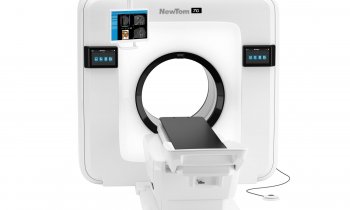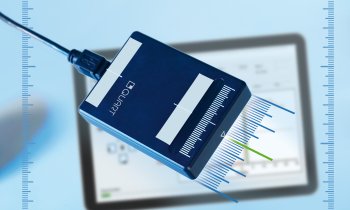Dual energy brings more to meet the eye
How does spectral – or dual energy – imaging work? Very similar to red and green light used in black-and-white photography. A black-and-white camera provides information on the colours of the photographed objects: an object that is black under red light is actually green.

Different photon energies generate differently coloured light. ‘Spectral imaging applies the same knowledge to X-rays in order to increase the informational content in the images,’ says Professor Thorsten Johnson who until recently headed the CT department of the University Hospital Munich at Grosshadern. With his team he shaped the development and the clinical application of dual energy imaging.
While in spectral imaging the X-ray image is created in conventional greyscale, but using different photon energies, the system manufacturers follow different approaches to achieve their results.
Dual energy: More information but same radiation dose
Siemens places two CTs with two X-ray tubes in one device. These radiation sources can be operated at different kV levels; they fire from different angles but from the same position on the axis simultaneously on two detectors. ‘We reconstruct images from both projections,’ Prof. Johnson explains, ‘and in a second step we analyse the images as to their spectral characteristics. In the data set we can identify different substances, particularly heavy elements such as iodine, xenon or calcium.’ Most – the most successful – applications use contrast agents that provide information on metabolic activities that indicate tumour presence.
With electricity shared by two tubes, valuable additional information is generated using normal dose. Thus high image quality can be achieved with a neutral ‘radiation footprint’.
Different technological approaches
Another approach – used, for example, by GE – is the so-called rapid KV switching technology (RAKV) however, which, as Professor Johnson points out, is not entirely dose-neutral. Philips, another major player in diagnostic imaging, offers a system with a detector equipped with two scintillator layers of different sensitivity. The crystals on these layers convert the incoming X-rays into visible light that in turn is detected by optical sensors.
Applications
Spectral imaging is suited for a wide range of applications. ‘In angiography the specific and quantitative detection of iodine contrast agent allows the complete removal of the background, including bone structures. This provides a much better overview of the region of interest and significantly facilitates diagnosis. In peripheral artery occlusive disease the vascular structure is much easier to see and evaluate,’ Prof. Johnson explains. In terms of 3-D reconstruction, projection without bones accelerates the assessment of intracranial aneurysms or arteriovenous malformations. In addition, with strokes speed is of the essence. During his term as Head of the CT Department at the Grosshadern University Hospital, he adds, ‘30-50 percent of all protocols were geared towards dual energy’.
The competition: MRI
For Prof. Johnson, MRI is clearly a competitor of spectral imaging. However, patient cohorts and the resource situation are completely different for the two modalities. While MRI scanners are rarely quickly available, and imaging takes quite some time, dual energy CT scanners are not yet widely used – also because in Germany, for example, the statutory health insurers do not reimburse the additional costs of spectral imaging.
Looking ahead
Where is spectral imaging development heading? According to Prof. Johnson, one trend is increased performance of the X-ray tubes: voltage changes in 10 kV steps, higher maximum, higher density filters. ‘This new generation of dual energy systems provides even better contrast – and thus more precise information.’ Whilst, so far, the focus has been on image quality, dose reduction is gaining importance. Today, the performance of the X-ray tubes can be optimised and the low-energy part of the spectrum, which significantly contributes to the radiation exposure, can be removed. Only radiation that travels through the patient is being used, not the radiation that ‘gets stuck’ in the patient’s fatty tissue. ‘Low-dose studies, for example of the lung, are possible with such a filtered spectrum,’ the radiologist emphasises.
To date, even applications once considered impossible due to the contrast-to-noise ratio seem promising. Bone marrow oedema, for example, might be visualised with enhanced spectral imaging. The same holds true for tendons, ligaments and cartilage – which are all difficult to image because of the weak signal. How can such potential be explored? Clinically indicated exams, the professor suggests, could simply be performed using conventional dose and spectral imaging. ‘This would be a dose-neutral way to see how precise the information is.’
Will Professor Johnson himself – having helped shape the development of dual energy as a long-term researcher and consultant for Siemens – continue to play an active part in spectral imaging? Within his institution Dr Johnson recently transferred to MRI – not without mixed feelings – but, ‘as a radiologist I aim to master all modalities. Today, it’s simply not enough for a clinical radiologist to only be familiar with CT.’ Nevertheless he will continue to lead several research projects in dual energy CT and he is curious to see whether, and which, applications are technically feasible and which one will make it from the research lab to clinical usage.
Summing up
‘Conventional CT can only visualise morphology. It is the physician who must draw conclusions regarding functional aspects,’ Prof. Johnson points out. ‘Dual energy introduces functional imaging to CT. It shows perfusion defects, or whether a kidney stone is composed of uric acid and can therefore be dissolved with drugs, or whether a haemorrhagic renal cyst does not take up contrast agent, which means it’s not a tumour. The additional information that functional and molecular CT imaging provides allows a much more specific diagnosis without higher radiation dose. I’m proud that today this method, which I was fortunate to co-develop, delivers on its promise in clinical practice and in research worldwide.’
Profile:
Graduating in medicine (summa cum laude) and undertaking research at Siemens AG’s CT department in Forchheim, Thorsten Johnson continued his physician training and his habilitation in radiology at Ludwig Maximilian University (LMU) in Munich. He was a senior resident and head of the CT division at the Institute of Clinical Radiology at LMU Hospital and held a senior position at the institute’s MRI division. In 2013 he was appointed professor.
03.03.2014











